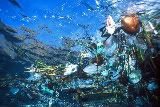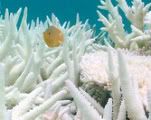Imagine vast expanses of oceans devoid of life as far and wide as you can project your senses, no whales, no fish, no seabirds and no corals beneath. The warm seawater is thick with floating plastic wastes and slime, and the oppressive heavy air putrid with death and decay..

That's not a scene from a science-fiction film, but a likely future scenario unless we take appropriate action now: stop polluting and exploiting the oceans and shift comprehensively to renewable energy options to drastically reduce carbon emissions..
Increase in carbon dioxide concentration in the atmosphere and global warming are threatening the oceans' phytoplankton that supports all marine life from zooplankton to whales. Phytoplankton is also the fastest assimilator of carbon, clearing carbon dioxide from the atmosphere to prevent it building up as a greenhouse gas that warms the earth..
What Is Ocean Acidification?
As carbon dioxide levels increase in the atmosphere the amount the oceans absorb also increases, leading to chemical changes that result in the oceans becoming more acidic. While the oceans are becoming more acidic, (technically, less basic) they are still on the basic side of the pH scale (basic - netural - acidic). It is highly unlikely that the oceans will ever become actual acid. However, even small changes in the acidity of the oceans can result in severe ramifications. If they become too acidic, corals and other organisms will be unable to build new skeletons and shells and those that already exist will begin to dissolve..
The oceans absorb carbon dioxide from the atmosphere, which reacts with sea water to produce carbonic acid and also reduces the amount of available carbonate. Corals and other organisms use carbonate to produce their calcium carbonate (limestone) skeletons and shells. The acid that is produced eats away at the shells and skeletons and dissolves them. The lack of carbonate means that corals and other organisms will find it increasingly difficult to produce their skeletons and shells.. It will be similar to trying to build a house while someone keeps stealing the bricks!
Ocean Acidification
Lets take a brief look at the Carbon Cycle and see how Ocean Acidification occurs:
The carbon cycle is the biogeochemical cycle by which carbon is exchanged between the biosphere, geosphere, hydrosphere, and atmosphere of the Earth..
The oceans contain around 36,000 gigatonnes of carbon, mostly in the form of bicarbonate ion. Inorganic carbon, that is carbon compounds with no carbon-carbon or carbon-hydrogen bonds, is important in its reactions within water. This carbon exchange becomes important in controlling pH in the ocean and can also vary as a source or sink for carbon. Carbon is readily exchanged between the atmosphere and ocean. In regions of oceanic upwelling, carbon is released to the atmosphere. Conversely, regions of downwelling transfer carbon (CO2) from the atmosphere to the ocean..
When CO2 enters the ocean, carbonic acid is formed:
CO2 + H2O ? H2CO3
This reaction has a forward and reverse rate, that is it achieves a chemical equilibrium. Another reaction important in controlling oceanic pH levels is the release of hydrogen ions and bicarbonate..
This reaction controls large changes in pH:
H2CO3 ? H+ + HCO3-
In the oceans, bicarbonate can combine with calcium to form limestone (calcium carbonate, CaCO3, with silica), which precipitates to the ocean floor. Limestone is the largest reservoir of carbon in the carbon cycle.. The calcium comes from the weathering of calcium-silicate rocks, which causes the silicon in the rocks to combine with oxygen to form sand or quartz (silicon dioxide), leaving calcium ions available to form limestone..
The Carbon Cycle
The Changing Ocean Environment
Global warming should be called ocean warming, as more than 80% of the added heat resides in the ocean. Clear alterations to the ocean have already been detected from observations. The magnitude and patterns of these changes are consistent with an attribution to human activities and not explained by natural variability alone..
Over half of human carbon dioxide emissions to the atmosphere are absorbed by the ocean and land biospheres, and the excess carbon absorbed by the ocean results in increased ocean acidity. The physical and chemical mechanisms by which this occurs are well understood. Once carbon dioxide enters the ocean, it combines with water to form carbonic acid and a series of acid-base products, resulting in a lowering of pH values. The amount and distribution of human-generated carbon in the oceans are well determined from an international ocean survey conducted in the late 1980s and early 1990s. The rate of ocean carbon uptake is controlled by ocean circulation. Most of the excess carbon is found in the upper few hundred meters of the ocean (upper 1200 feet) and in high-latitude regions, where cold dense waters sink into the deep ocean..

Bleached Coral
Increase in carbon dioxide concentration in the atmosphere and global warming are threatening the oceans' phytoplankton that supports all marine life from zooplankton to whales. Phytoplankton is also the fastest assimilator of carbon, clearing carbon dioxide from the atmosphere to prevent it building up as a greenhouse gas that warms the earth..
When phytoplankton is in jeopardy, all life is in jeopardy, on land and at sea. Marine life will literally starve to death, and the decay and decomposition that follow would release enormous amounts of carbon dioxide from the estimated 800 Gt of the ocean's standing biomass, resulting in further global warming on a massive scale..
Marine Food Web At Risk
The failure of pteropods to thrive will affect many species, as they contribute to the diet of diverse species of other zooplankton, small fishes, the North Pacific Salmon, mackerel herring, cod and baleen whales..
Surface dwelling calcite plankton such as foraminifera and coccolithophorids may fare better in the short term. However, the beginning of high-latitude-calcite under-saturation will only lag aragonite by 50 to 100 years. The diverse bottom-dwelling calcareous organisms in high latitude regions may also be threatened, including cold-water corals, which provide essential fish habitat. Cold-water corals seem much less abundant in the North Pacific than in the North Atlantic where the aragonite saturation horizon is much deeper. Some important groups in the Arctic and Antarctic bottom-dwelling communities secrete magnesium calcite, which can be more soluble than aragonite. These include gorgonians, coralline red algae and echinoderms. At twice the normal concentration of carbon dioxide, juvenile echinoderms stopped growing and produced more brittle and fragile exoskeletons in a subtropical six-month experiment. Experimental evidence from many lower-latitude, shallow-dwelling calcifiers reveals a reduced ability to calcify with a decreasing carbonate saturation state. At twice the normal carbon dioxide concentration, calcification rates in some shallow-dwelling calcareous organisms may decline by up to 50 percent..
Plankton
How Can We Stop Acidification?
The only way to stop ocean acidification is to reduce the amount of carbon dioxide being absorbed by the oceans. We can do this by reducing the amount of carbon dioxide we release into the atmosphere..
Reduce Your Carbon Footprint!
A Carbon Footprint is a measure of the impact our activities have on the environment in terms of the amount of greenhouse gases we produce. It is measured in units of carbon dioxide..

How big is yours? Find out, then reduce it and offset it!
Visit Carbon Footprint. com and discover what you can do to reduce your carbon footprint!
Top 50 Things To Do To Stop Global Warming
Top Tips to reduce CO2 emissions
Going vegetarian/vegan is perhaps the most effective
way to reduce your carbon footprint!
The burning of fossil fuels (such as oil and gasoline) releases carbon dioxide, the primary gas responsible for global warming. Producing one calorie of animal protein requires more than 10 times as much fossil fuel input—releasing more than 10 times as much carbon dioxide—than does a calorie of plant protein.3 Feeding massive amounts of grain and water to farmed animals and then killing them and processing, transporting, and storing their flesh is extremely energy-intensive. In addition, enormous amounts of carbon dioxide stored in trees are released during the destruction of vast acres of forest to provide pasture land and to grow crops for farmed animals. On top of this, animal manure also releases large quantities of carbon dioxide..


Future generations deserve to see an unbleached spongebob!
For more information visit these sources & links:
Oceana
Mongabay. com
Science Daily
Center For Biological Diversity
The Ocean Acidification Network
Real Climate. org

Aquaman ~ Ocean Defender
{Additional programming by the DPC}

